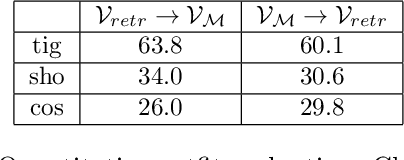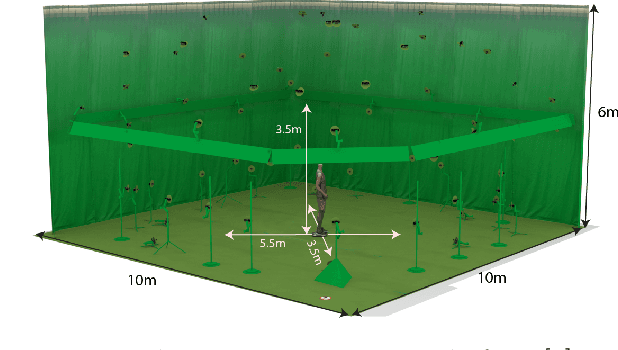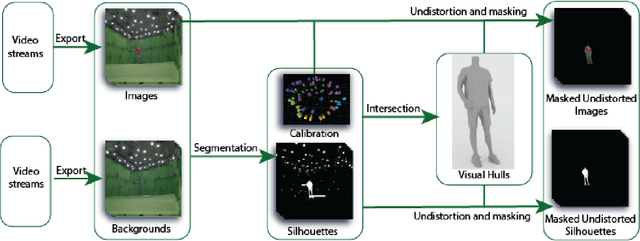Vincent Leroy
Pow3R: Empowering Unconstrained 3D Reconstruction with Camera and Scene Priors
Mar 21, 2025Abstract:We present Pow3r, a novel large 3D vision regression model that is highly versatile in the input modalities it accepts. Unlike previous feed-forward models that lack any mechanism to exploit known camera or scene priors at test time, Pow3r incorporates any combination of auxiliary information such as intrinsics, relative pose, dense or sparse depth, alongside input images, within a single network. Building upon the recent DUSt3R paradigm, a transformer-based architecture that leverages powerful pre-training, our lightweight and versatile conditioning acts as additional guidance for the network to predict more accurate estimates when auxiliary information is available. During training we feed the model with random subsets of modalities at each iteration, which enables the model to operate under different levels of known priors at test time. This in turn opens up new capabilities, such as performing inference in native image resolution, or point-cloud completion. Our experiments on 3D reconstruction, depth completion, multi-view depth prediction, multi-view stereo, and multi-view pose estimation tasks yield state-of-the-art results and confirm the effectiveness of Pow3r at exploiting all available information. The project webpage is https://europe.naverlabs.com/pow3r.
MUSt3R: Multi-view Network for Stereo 3D Reconstruction
Mar 03, 2025Abstract:DUSt3R introduced a novel paradigm in geometric computer vision by proposing a model that can provide dense and unconstrained Stereo 3D Reconstruction of arbitrary image collections with no prior information about camera calibration nor viewpoint poses. Under the hood, however, DUSt3R processes image pairs, regressing local 3D reconstructions that need to be aligned in a global coordinate system. The number of pairs, growing quadratically, is an inherent limitation that becomes especially concerning for robust and fast optimization in the case of large image collections. In this paper, we propose an extension of DUSt3R from pairs to multiple views, that addresses all aforementioned concerns. Indeed, we propose a Multi-view Network for Stereo 3D Reconstruction, or MUSt3R, that modifies the DUSt3R architecture by making it symmetric and extending it to directly predict 3D structure for all views in a common coordinate frame. Second, we entail the model with a multi-layer memory mechanism which allows to reduce the computational complexity and to scale the reconstruction to large collections, inferring thousands of 3D pointmaps at high frame-rates with limited added complexity. The framework is designed to perform 3D reconstruction both offline and online, and hence can be seamlessly applied to SfM and visual SLAM scenarios showing state-of-the-art performance on various 3D downstream tasks, including uncalibrated Visual Odometry, relative camera pose, scale and focal estimation, 3D reconstruction and multi-view depth estimation.
MASt3R-SfM: a Fully-Integrated Solution for Unconstrained Structure-from-Motion
Sep 27, 2024



Abstract:Structure-from-Motion (SfM), a task aiming at jointly recovering camera poses and 3D geometry of a scene given a set of images, remains a hard problem with still many open challenges despite decades of significant progress. The traditional solution for SfM consists of a complex pipeline of minimal solvers which tends to propagate errors and fails when images do not sufficiently overlap, have too little motion, etc. Recent methods have attempted to revisit this paradigm, but we empirically show that they fall short of fixing these core issues. In this paper, we propose instead to build upon a recently released foundation model for 3D vision that can robustly produce local 3D reconstructions and accurate matches. We introduce a low-memory approach to accurately align these local reconstructions in a global coordinate system. We further show that such foundation models can serve as efficient image retrievers without any overhead, reducing the overall complexity from quadratic to linear. Overall, our novel SfM pipeline is simple, scalable, fast and truly unconstrained, i.e. it can handle any collection of images, ordered or not. Extensive experiments on multiple benchmarks show that our method provides steady performance across diverse settings, especially outperforming existing methods in small- and medium-scale settings.
Grounding Image Matching in 3D with MASt3R
Jun 14, 2024



Abstract:Image Matching is a core component of all best-performing algorithms and pipelines in 3D vision. Yet despite matching being fundamentally a 3D problem, intrinsically linked to camera pose and scene geometry, it is typically treated as a 2D problem. This makes sense as the goal of matching is to establish correspondences between 2D pixel fields, but also seems like a potentially hazardous choice. In this work, we take a different stance and propose to cast matching as a 3D task with DUSt3R, a recent and powerful 3D reconstruction framework based on Transformers. Based on pointmaps regression, this method displayed impressive robustness in matching views with extreme viewpoint changes, yet with limited accuracy. We aim here to improve the matching capabilities of such an approach while preserving its robustness. We thus propose to augment the DUSt3R network with a new head that outputs dense local features, trained with an additional matching loss. We further address the issue of quadratic complexity of dense matching, which becomes prohibitively slow for downstream applications if not carefully treated. We introduce a fast reciprocal matching scheme that not only accelerates matching by orders of magnitude, but also comes with theoretical guarantees and, lastly, yields improved results. Extensive experiments show that our approach, coined MASt3R, significantly outperforms the state of the art on multiple matching tasks. In particular, it beats the best published methods by 30% (absolute improvement) in VCRE AUC on the extremely challenging Map-free localization dataset.
DUSt3R: Geometric 3D Vision Made Easy
Dec 21, 2023



Abstract:Multi-view stereo reconstruction (MVS) in the wild requires to first estimate the camera parameters e.g. intrinsic and extrinsic parameters. These are usually tedious and cumbersome to obtain, yet they are mandatory to triangulate corresponding pixels in 3D space, which is the core of all best performing MVS algorithms. In this work, we take an opposite stance and introduce DUSt3R, a radically novel paradigm for Dense and Unconstrained Stereo 3D Reconstruction of arbitrary image collections, i.e. operating without prior information about camera calibration nor viewpoint poses. We cast the pairwise reconstruction problem as a regression of pointmaps, relaxing the hard constraints of usual projective camera models. We show that this formulation smoothly unifies the monocular and binocular reconstruction cases. In the case where more than two images are provided, we further propose a simple yet effective global alignment strategy that expresses all pairwise pointmaps in a common reference frame. We base our network architecture on standard Transformer encoders and decoders, allowing us to leverage powerful pretrained models. Our formulation directly provides a 3D model of the scene as well as depth information, but interestingly, we can seamlessly recover from it, pixel matches, relative and absolute camera. Exhaustive experiments on all these tasks showcase that the proposed DUSt3R can unify various 3D vision tasks and set new SoTAs on monocular/multi-view depth estimation as well as relative pose estimation. In summary, DUSt3R makes many geometric 3D vision tasks easy.
Cross-view and Cross-pose Completion for 3D Human Understanding
Nov 15, 2023



Abstract:Human perception and understanding is a major domain of computer vision which, like many other vision subdomains recently, stands to gain from the use of large models pre-trained on large datasets. We hypothesize that the most common pre-training strategy of relying on general purpose, object-centric image datasets such as ImageNet, is limited by an important domain shift. On the other hand, collecting domain specific ground truth such as 2D or 3D labels does not scale well. Therefore, we propose a pre-training approach based on self-supervised learning that works on human-centric data using only images. Our method uses pairs of images of humans: the first is partially masked and the model is trained to reconstruct the masked parts given the visible ones and a second image. It relies on both stereoscopic (cross-view) pairs, and temporal (cross-pose) pairs taken from videos, in order to learn priors about 3D as well as human motion. We pre-train a model for body-centric tasks and one for hand-centric tasks. With a generic transformer architecture, these models outperform existing self-supervised pre-training methods on a wide set of human-centric downstream tasks, and obtain state-of-the-art performance for instance when fine-tuning for model-based and model-free human mesh recovery.
Win-Win: Training High-Resolution Vision Transformers from Two Windows
Oct 01, 2023Abstract:Transformers have become the standard in state-of-the-art vision architectures, achieving impressive performance on both image-level and dense pixelwise tasks. However, training vision transformers for high-resolution pixelwise tasks has a prohibitive cost. Typical solutions boil down to hierarchical architectures, fast and approximate attention, or training on low-resolution crops. This latter solution does not constrain architectural choices, but it leads to a clear performance drop when testing at resolutions significantly higher than that used for training, thus requiring ad-hoc and slow post-processing schemes. In this paper, we propose a novel strategy for efficient training and inference of high-resolution vision transformers: the key principle is to mask out most of the high-resolution inputs during training, keeping only N random windows. This allows the model to learn local interactions between tokens inside each window, and global interactions between tokens from different windows. As a result, the model can directly process the high-resolution input at test time without any special trick. We show that this strategy is effective when using relative positional embedding such as rotary embeddings. It is 4 times faster to train than a full-resolution network, and it is straightforward to use at test time compared to existing approaches. We apply this strategy to the dense monocular task of semantic segmentation, and find that a simple setting with 2 windows performs best, hence the name of our method: Win-Win. To demonstrate the generality of our contribution, we further extend it to the binocular task of optical flow, reaching state-of-the-art performance on the Spring benchmark that contains Full-HD images with an inference time an order of magnitude faster than the best competitor.
SHOWMe: Benchmarking Object-agnostic Hand-Object 3D Reconstruction
Sep 19, 2023Abstract:Recent hand-object interaction datasets show limited real object variability and rely on fitting the MANO parametric model to obtain groundtruth hand shapes. To go beyond these limitations and spur further research, we introduce the SHOWMe dataset which consists of 96 videos, annotated with real and detailed hand-object 3D textured meshes. Following recent work, we consider a rigid hand-object scenario, in which the pose of the hand with respect to the object remains constant during the whole video sequence. This assumption allows us to register sub-millimetre-precise groundtruth 3D scans to the image sequences in SHOWMe. Although simpler, this hypothesis makes sense in terms of applications where the required accuracy and level of detail is important eg., object hand-over in human-robot collaboration, object scanning, or manipulation and contact point analysis. Importantly, the rigidity of the hand-object systems allows to tackle video-based 3D reconstruction of unknown hand-held objects using a 2-stage pipeline consisting of a rigid registration step followed by a multi-view reconstruction (MVR) part. We carefully evaluate a set of non-trivial baselines for these two stages and show that it is possible to achieve promising object-agnostic 3D hand-object reconstructions employing an SfM toolbox or a hand pose estimator to recover the rigid transforms and off-the-shelf MVR algorithms. However, these methods remain sensitive to the initial camera pose estimates which might be imprecise due to lack of textures on the objects or heavy occlusions of the hands, leaving room for improvements in the reconstruction. Code and dataset are available at https://europe.naverlabs.com/research/showme
4DHumanOutfit: a multi-subject 4D dataset of human motion sequences in varying outfits exhibiting large displacements
Jun 12, 2023



Abstract:This work presents 4DHumanOutfit, a new dataset of densely sampled spatio-temporal 4D human motion data of different actors, outfits and motions. The dataset is designed to contain different actors wearing different outfits while performing different motions in each outfit. In this way, the dataset can be seen as a cube of data containing 4D motion sequences along 3 axes with identity, outfit and motion. This rich dataset has numerous potential applications for the processing and creation of digital humans, e.g. augmented reality, avatar creation and virtual try on. 4DHumanOutfit is released for research purposes at https://kinovis.inria.fr/4dhumanoutfit/. In addition to image data and 4D reconstructions, the dataset includes reference solutions for each axis. We present independent baselines along each axis that demonstrate the value of these reference solutions for evaluation tasks.
Improved Cross-view Completion Pre-training for Stereo Matching
Nov 18, 2022



Abstract:Despite impressive performance for high-level downstream tasks, self-supervised pre-training methods have not yet fully delivered on dense geometric vision tasks such as stereo matching. The application of self-supervised learning concepts, such as instance discrimination or masked image modeling, to geometric tasks is an active area of research. In this work we build on the recent cross-view completion framework: this variation of masked image modeling leverages a second view from the same scene, which is well suited for binocular downstream tasks. However, the applicability of this concept has so far been limited in at least two ways: (a) by the difficulty of collecting real-world image pairs - in practice only synthetic data had been used - and (b) by the lack of generalization of vanilla transformers to dense downstream tasks for which relative position is more meaningful than absolute position. We explore three avenues of improvement: first, we introduce a method to collect suitable real-world image pairs at large scale. Second, we experiment with relative positional embeddings and demonstrate that they enable vision transformers to perform substantially better. Third, we scale up vision transformer based cross-completion architectures, which is made possible by the use of large amounts of data. With these improvements, we show for the first time that state-of-the-art results on deep stereo matching can be reached without using any standard task-specific techniques like correlation volume, iterative estimation or multi-scale reasoning.
 Add to Chrome
Add to Chrome Add to Firefox
Add to Firefox Add to Edge
Add to Edge